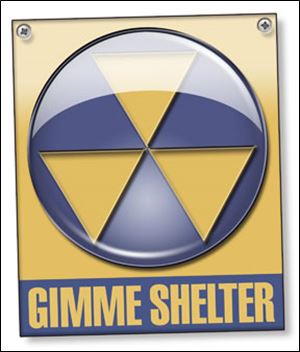
Going underground in an area bunker
11/28/2007 Gimme Shelter (large)
Gimme Shelter (large)
<br> <img src=http://www.toledoblade.com/assets/gif/TO1599743.GIF> <b><font color=red>MULTIMEDIA: </b></font color=red> <a href=" /Assets/sheltershows/index.html"target="_blank "><b>Gimme Shelter</b></a> (large) <br> <img src=http://www.toledoblade.com/assets/gif/TO1599743.GIF> <b><font color=red>MULTIMEDIA: </b></font color=red> <a href=" /Assets/sheltershows/small.html"target="_blank "><b>Gimme Shelter</b></a> (small)
Just outside the South Toledo home of Eric Tipton is the entrance to his personal underground bunker.
Dr. Strangelove would be proud.
A large metal lid sits atop a square concrete hole in the ground. A rusty ladder descends into the darkness of the shelter, which has a large water tank but no windows or visible means of ventilation. There's not enough space to stand and barely room for a few people to sit.
It's just a small, narrow, thick-walled room - a relic of an age of paranoia and fears of nuclear attack.
"It's a little comical to me. What would this protect you from?" said Mr. Tipton, who was told by a former owner that the bunker was the work of a veteran who feared Japanese retaliation after World War II.
Aside from perhaps a tornado shelter, the 34-year-old doesn't see much use for it nowadays, even with all the talk of dirty bombs and terrorist threats. Mr. Tipton dumps some mulch over the bunker and lets it sit empty.
That's been the fate of many fallout shelters around the country since the government allowed its national program to fade away after the end of the Cold War. The last list of approved shelters was published in 1992.
New fears raised by a world with al Qaeda have led one Alabama community to revive and expand its old fallout-shelter plan in case radioactive fallout is scattered by a terrorist nuclear bomb. News reports indicate that the town, Huntsville, has an ambitious plan developed with $70,000 in Homeland Security funding that includes using an abandoned mine to protect up to 20,000 people underground.
But in most places, including Toledo, all that remains of public fallout shelters are the iconic, yellow-and-black signs. Even those are gone in many cases.
The program started in the early 1960s when the government acquired 165,000 tons of food, which was stocked in approximately 100,000 shelters across the U.S. between 1962 and 1970, according to a 1978 Civil Preparedness Guide cited at the virtual Civil Defense Museum (www.civildefensemuseum.com), a Web site maintained by Texas resident and fallout shelter enthusiast Eric Green.
In the event of a nuclear attack, it was believed that people could hide in such shelters for two weeks while radiation levels from fallout subsided. The facilities were not chosen for blast protection.
"If everything wouldn't have been blown up ... maybe [they] would have worked," Mr. Green said.
More than anything, the public looked to shelters for hope.
"There was this terrible, terrible fear of a nuclear exchange," said Donald McQuarie, director of the American culture studies program at Bowling Green State University.
European communities, fresh with memories of bombing during World War II, built public fallout shelters too, but the popular appearance of private ones like that at Mr. Tipton's home was peculiar to the U.S., he said.
Bill Halsey isn't aware of other homes in the area equipped with special fallout shelters, but he does remember when there were 255 licensed public shelters in the county. As the director of the Lucas County Emergency Management Agency, it was his duty for years to make sure that those areas were properly equipped.
"The buildings were stocked with food, water, medical supplies, sanitation kits, Geiger counters, and that was about it," he said.
By food, he means no-salt survival crackers that tasted "terrible" and some candy. Each person was allotted a paltry 800 calories a day. The toilet paper was itchy and the 17 1/2-gallon cardboard drums used to store supplies doubled as toilets - not an ideal environment for spending a prolonged period of time.
The average local shelter, often a sturdy school, office, or government building, could accommodate about 200 people, Mr. Halsey said. Most were in basements or even on the upper floors of high rise buildings to provide separation from radioactive fallout collecting on the ground after a nuclear attack.
Now that the plan is discontinued, some of the spaces are used for storage or have been converted to other uses, said Mr. Halsey, who collected the Geiger counters and removed thousands of water barrels over the years. (The crackers had been removed years before when the government ruled it had expired.)
So far there has been no movement to restore the fallout shelters program, even with talk of dirty bombs and the actions of Huntsville, Ala.
"We are doing nothing, and I don't think most of the nation is doing anything in terms of fallout shelters," Mr. Halsey said.
Instead, authorities have created contingency plans for a large-scale evacuation in the case of a terrorist act or - more likely - a large-scale natural disaster. For a chemical explosion (caused by terrorists or otherwise), the plan is for a temporary "shelter-in-place," asking people to place wet rags under their doors and close their windows until the threat passes.
As for Mr. Tipton's shelter in South Toledo, he's happy to leave it empty and irrelevant. He sees it as an artifact of another era, filled with rusting metal and a spattering of mud that's managed to ooze inside.
"I'll just leave it be," he said. "I just don't have a use for it."
Contact Ryan E. Smith at:
ryansmith@theblade.com
or 419-724-6103.